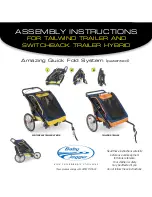
88
89
The following routines are essential for suspension
fork maintenance:
Whatever type of fork you have, make sure the slid-
ing surfaces of the upper fork tubes are absolutely
clean. Clean the fork with water and a soft sponge
after every ride. After washing your bicycle, spray
the stanchion tubes of the suspension fork with a
little grease spray or apply a very thin film of hy-
draulic oil. Do not use a steam jet or aggressive
cleaning agents!
Make it a rule to check all bolted connections of
your fork at regular intervals.
Keep the upper tubes of the fork legs always clean
SUSPENSION FORK
ADJUSTMENT AND MAINTENANCE
i
Please read the enclosed manual of the
fork manufacturer or visit the according
website.
Suspension forks are of sophisticated de-
sign. Leave all maintenance and repair
work to a service centre authorized by the fork
manufacturer. Use a suitable torque wrench and
observe the manufacturer’s torque settings when
checking the bolted connections on your suspen-
sion fork!
When buying a new tyre for your front
wheel, make sure it is not too high. Oth-
erwise it might drag along the fork crown with
a completely compressed fork. The front wheel
might get jammed.
Risk of an accident!
!
Suspension forks are designed in a way to
absorb shocks. If the fork is too rigid and
jammed, the terrain induced shocks pass directly
into the frame without any damping. The frame
is normally not designed to withstand such un-
damped stresses. If your bicycle is equipped with
a suspension fork including lockout, you should
keep in mind not to activate the lockout function
when riding over rough terrain, but only when
riding over smooth terrain (tarred roads, smooth
tracks).
i
Suspension forks are constantly being
sprayed with water and dirt from the front
wheel. Clean them with lots of water after every
ride.
FULL-SUSPENSION
Full-suspension bikes are not only equipped with a
suspension fork but also with a movable rear frame
which is sprung and shock damped by a shock ab-
sorber. Depending on the system the rear shock has
one or more suspension axes with at least two bear-
ings each. Shock absorption is afforded by a steel or
air spring, and damping usually by oil.
WHAT TO BEAR IN MIND WHEN ADjUSTING THE
SADDLE
Full-suspension bikes yield a little when the rider sits
on the saddle. This causes the saddle to tilt a little
backwards, an effect which can be compensated by
adjusting the position of the saddle. If you have trou-
ble sitting, try lowering the saddle nose a little rela-
tive to the usual position.
ADjUSTMENT AND MAINTENANCE
The spring characteristic of the shock absorber must
be adjusted to the rider’s weight and sitting posture.
The rear shock of the rear swing arm should retract
slightly under the rider’s weight to allow for a little
sag. With cross-country and marathon bikes we rec-
ommend a sag of approx. 10 - 25 %, with enduro and
freeride bikes a sag of approx. 20 - 40 %.
When the rear wheel passes over a hole, the spring
will extend and the suspension mechanism will
smoothen the uneven movement. If the initial spring
tension is set too high, this effect is lost as the wheel
will already be fully extended. This means the loss of
an important feature of safety and comfort.
Rear-frame suspension
FULL-SUSPENSION
The O-ring on the damper in top position
The O-ring displaced on the damper shows the spring travel used
i
For more information see the
suspension
glossary
heading this chapter.
i
Full-suspension bikes have a markedly
greater ground clearance than bikes with-
out suspension. If the saddle is adjusted to its
proper height, you will not be able to reach the
floor with your feet. Set the saddle a little lower
to begin with and practise getting on and off the
saddle.











































